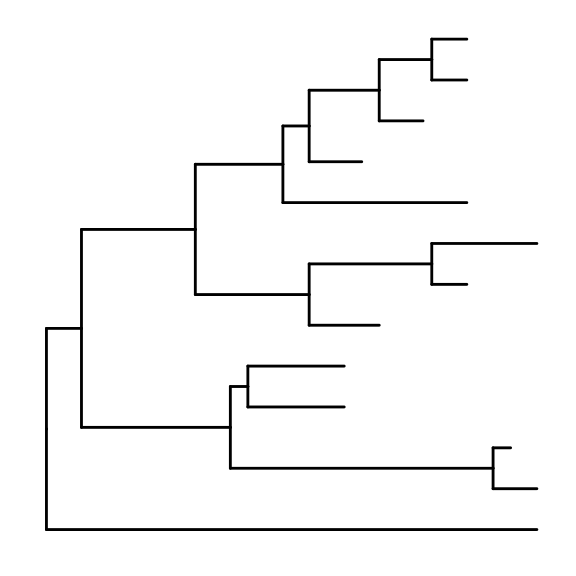BIOL 108 - Theme I - Systematics and Phylogeny
1/25
There's no tags or description
Looks like no tags are added yet.
Name | Mastery | Learn | Test | Matching | Spaced |
|---|
No study sessions yet.
26 Terms
Evolutionary Taxonomy
Discipline of naming and classifying things in the context of evolution, using Linnaean classification
Systematics
Focused on classifying organisms based on their evolutionary relationships and history
Phylogenetics
Field of systematics focused on evolutionary relationships among/between organisms
Cladistics
Uses a tree of diverging branches based on shared derived features (similarities). Direct ancestors aren’t specified, but treated as hypothetical.
Challenges of Linnaean In Phylogenetics
Number of ranks is limited
-Not enough ranks to accommodate every taxon
Ranks on phylogeny may not be comparable
Phylogenetic Tree
Evolutionary hypothesis of a group of biologically related taxa (such as a species).
It depicts lineages from a common ancestor, and evolutionary patterns.
Assists in classification of organisms.

Parts of a Phylogenetic Tree
Root - Base of phylogeny
Tips - Terminals of the phylogeny
Node - Represents a hypothetical last common ancestor, and divergence
External Node - Connected to a node and a tip
Internal Node - Connected to two nodes
Branch/Clade - Lines connecting nodes
Ingroup - Taxa under study
Outgroup - Taxa not under study
Sister Taxa - Two closes branches from a node
Basal Taxa - Relatively early divergence
Derived Taxa - Relatively late divergence
Monophyly/Monophyletic Group
A clade that includes the most recent common ancestor and all of its descendants (eg, mammals)
Paraphyletic Group
Group that includes the most recent common ancestor and some of its descendants
Polyphyletic Group
A group that includes some of its descendants without their common ancestor (eg, animals that can fly)
Dichotomy and Polytomy
Dichotomy - Only two branches diverge from a common ancestor (node)
Polytomy - More than two branches diverge from a common ancestor (node)
Soft and Hard Polytomy
Soft Polytomy - Uncertainty about which of the taxa from the node are closely related
More data and experiments needed
Hard Polytomy - Hypothesis that more than two taxa arose from a common ancestor
Conclusion; Evolutionary event likely has taken place
Morphological Data
Anatomical features;
Qualitative (colour, shape, etc)
Quantitative (measurements)
Measurements are often rigorous, fossils can assist in this determination
Can be used to build phylogenetics by helping determine common traits
Molecular Data
Genomic (DNA sequence), protein structure, etc.
Can be used to build phylogenetics by helping determine common traits
Homology
Character traits that evolved from a common ancestral structure. These traits are similar due to shared ancestry among taxa.
Analogy
Character traits that independently evolved from convergence evolution
Convergence evolution occurs when organisms from separated lineages adapt to similar environements
Analogous traits cannot be used for phylogeny, since it doesn’t demonstrate evolutionary relationships/shared ancestry
Synapomorphy
A derived feature shared by more than two taxa and their last common ancestor
Example; Shell is a synapomorphy of turtles
Autapomorphy
Derived feature found only in one taxa
Example; A species
Symplesiomorphy
Ancestral feature shared by at least some members of a taxonomic group
Example: fur covering most of the body is a symplesiomorphy for mammals
Identification of An Outgroup
Typically the sister group of the ingroup is used as an outgroup
Character states are coded as numbers, outgroup is set to 0 to represent ancestral traits, or 1 and 2 to represent derived traits
Order of change is decided;
0 → 1 = Ancestral to Derived
1 → 0 = Derived to Ancestral
Computation performed to determine candidate trees, which are then selected based on their criteria
Maximal Parsimony
In Cladistics, the tree that implies the fewest evolutionary changes is the most likely tree
Methods of Phylogenetic Tree Determination
Maximal Parsimony
Maximum Likelihood
Bayesian Inference
Embryonic Development
A possible remedy in distinguising between ancestral and derived states.
Follows Von Baer’s law, the more general (basal) characters appear earlier in the embryo than the more special (derived) characters.
A trait developed at a relatively early stage across multiple taxa is more likely to be ancestral.
Problems with the Embryonic Development Theory
Ancestral traits don’t always appear in embryonic development, example being axolotl grills
Metamorphosis can occur, such as in insects or frogs
Fossil Evidence
A possible remedy in distinguising between ancestral and derived states.
Provides indisputable evidence of a taxa, with traits demonstrated by fossil taxa relatively early in Earth’s history likely being ancestral.
Problems with Fossil Evidence Usage
Fossil records are incomplete
Molecular data is rare in fossils, meaning we’re relying only on morphological data